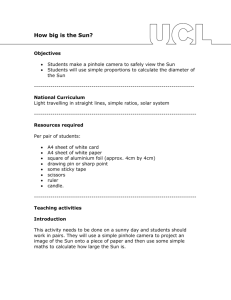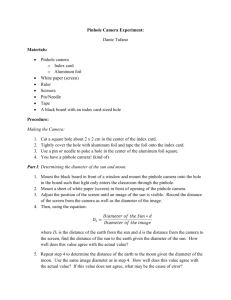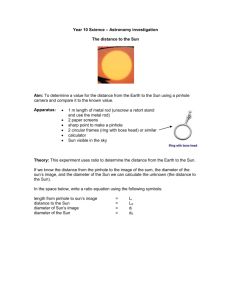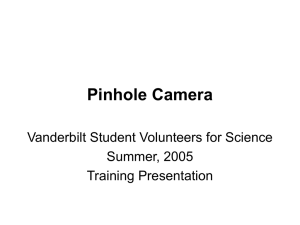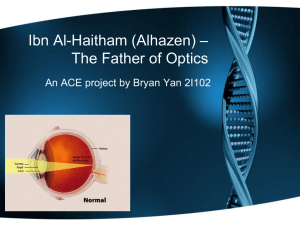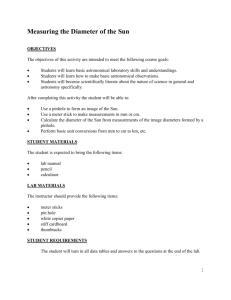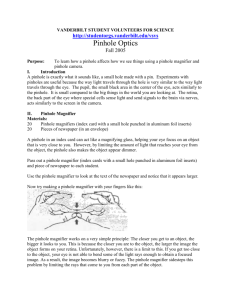Images
advertisement
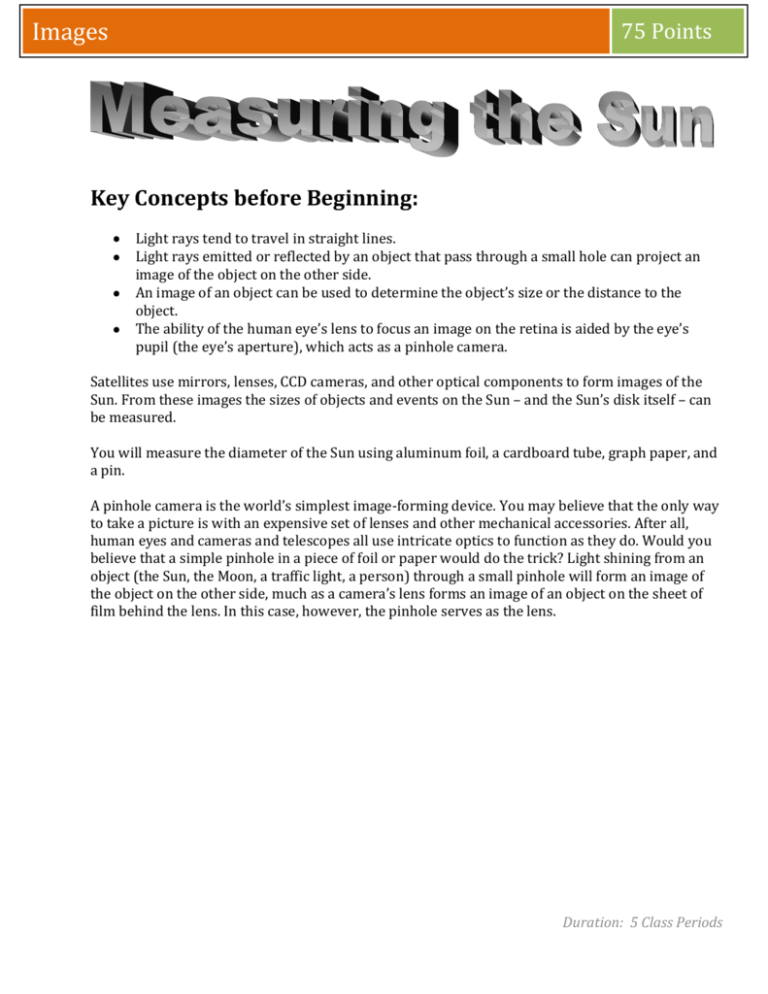
Images 75 Points Key Concepts before Beginning: Light rays tend to travel in straight lines. Light rays emitted or reflected by an object that pass through a small hole can project an image of the object on the other side. An image of an object can be used to determine the object’s size or the distance to the object. The ability of the human eye’s lens to focus an image on the retina is aided by the eye’s pupil (the eye’s aperture), which acts as a pinhole camera. Satellites use mirrors, lenses, CCD cameras, and other optical components to form images of the Sun. From these images the sizes of objects and events on the Sun – and the Sun’s disk itself – can be measured. You will measure the diameter of the Sun using aluminum foil, a cardboard tube, graph paper, and a pin. A pinhole camera is the world’s simplest image-forming device. You may believe that the only way to take a picture is with an expensive set of lenses and other mechanical accessories. After all, human eyes and cameras and telescopes all use intricate optics to function as they do. Would you believe that a simple pinhole in a piece of foil or paper would do the trick? Light shining from an object (the Sun, the Moon, a traffic light, a person) through a small pinhole will form an image of the object on the other side, much as a camera’s lens forms an image of an object on the sheet of film behind the lens. In this case, however, the pinhole serves as the lens. Duration: 5 Class Periods Images 75 Points Step 1: Building your Pinhole Camera 1. Find and/or assemble the tube. The tube should be at least 30 inches long, but even longer is better. (Gift-wrap-paper cardboard tubes can be used, either in single lengths or taped together end-to-end.) 2. Near one end of the tube (half an inch or less from the end), cut out a hole. The hole should be large enough so that you can see most of the opening at the end of the tube from the inside. 3. Cut out a piece of lined graph paper (with a millimeter grid spacing, if possible) just large enough to fit in one end of the tube. 4. Tape the graph paper to cover the opening at the end of the tube— the same end in which you cut the viewing hole. 5. Cut out a piece of aluminum foil just large enough to fit on the end of the tube opposite the graph paper. (Or you could cut out a larger piece that can be wrapped over the end of the tube, as shown in the diagram.) 6. Tape the foil to the end of the tube opposite the graph paper. Note: It is important that the foil be smooth, flat, and taut, like a drumhead. 7. Using a sharp point no bigger than that of a pin, poke a very small hole in the center of the aluminum foil. 8. Your pinhole camera is ready to use! Duration: 5 Class Periods Images 75 Points Step 2: Observe Your pinhole camera has been designed specifically to measure the diameter of the Sun. Before you observe the Sun with it, repeat the following sentence one thousand times: I will not look directly at the Sun! It is very important that you do not look directly at the Sun, not with a telescope, not with a camera, not with a pair of binoculars, and not with your pinhole camera. The design of you pinhole camera makes it easy to measure the size of the Sun’s image without being in danger of accidentally letting direct sunlight into your eyes. When you point the tube at the Sun and look into the viewer, you are looking away from Observing Steps the Sun, which is always the safest thing to do. 1. Stand facing away from the Sun. 2. Lift the viewer hole to your eye and point the tube over your shoulder in the direction of the Sun. 3. Try to find the Sun’s image on the graph paper, looking through the viewing hole. When your pinhole camera is pointed properly at the Sun, you will see a small spot of light on the graph paper. The size of the spot will depend on the length of your pinhole camera. If you have difficulty finding the Sun’s image (which will be a small and possibly faint spot of light on the graph paper) there is a trick you can try: Look at the shadow that your pinhole camera tube casts on the ground and move the camera around until its shadow is as small as possible. When the tube is pointed directly at the Sun, its shadow will be at its smallest. 4. When you find the Sun’s image, attempt to measure its size by counting the number of millimeter lines on the graph paper that it covers, from edge to edge (the image’s diameter). Make as careful a measurement as you can. If you have trouble reading the size of the Sun’s image because you cannot hold the camera still enough, try resting the camera on some solid object (a table, a chair, a window sill). 5. Record all of your measurements on the Data Sheet. Duration: 5 Class Periods Images 75 Points Data Sheet Measure the length of your tube from pinhole to projection screen. You should be accurate to the nearest 0.1 centimeter and then convert to meters by dividing by 100. Example: 65.2 cm = 0.652 m. Measure the height of your image of the Sun on the millimeter grid. Make at least three measurements and average your results. Show your work and record your result in millimeters. (This is the “h” value.) Trial #1__________ Trial #2__________ Trial #3__________ Convert the Sun image height to meters by dividing by 1000. Example: 8.5mm = 0.0085 m. Show your work. The mean distance to the Sun (your “D” value) is 1.496 x 1011 meters (about 93 million miles). For a pinhole camera, the relationship between the object size, the object distance, and the length of the camera is simple: H/D=h/d where H is the actual height (diameter) of the Sun, D is the distance to the Sun, h is the height of the Sun’s image on your projection screen, and d is the length of your camera tube. The diameter of the Sun, H, can be expressed as: H = D ( h/d ) Using your values for D, h, and d, calculate the diameter of the Sun. Carefully show the setup and all of your work here. Make sure all of your numbers are in meters, and your answer is in scientific notation rounded to two decimal places. Example: 7.36 x 106 meters. Questions: Duration: 5 Class Periods Images 75 Points 1. How close to the actual value is your value for the diameter of the Sun? In other words, was it within 0.1 x 109 meters, or not? 2. What could have caused your answer to be inaccurate? 3. How close to the class average is your value for the diameter of the Sun? 4. Explain how pinhole cameras of different lengths can achieve similar results for the diameter of the Sun. Step 3: Instrument Improvement (Pinhole Size) Determine the effect of pinhole size on Sun image size. Poke three holes, of different sizes, into the aluminum foil at your pinhole camera’s aperture end. Try using a thumbtack to make one of the holes, a pinpoint for another, and perhaps a very thin, sharp staple for a third. Space the three holes about a centimeter apart from one another. Observe the Sun with your triple-pinhole camera. Measure the image size for each of the three holes. Calculate the Sun’s diameter for each image size. Answer the following questions: 1. Is there a difference in the calculated diameter of the Sun for each of the different pinhole sizes? If so, what is the difference? Plot your results on a graph of Sun diameter versus pinhole size. 2. How important is pinhole size in producing accurate measurements? 3. Is there a difference in the brightnesses of the images produced by each pinhole? If so, why is this? The larger the pinhole, the more out of focus will be the image of the Sun’s disk. Smaller holes produce sharper images, and more accurate results. Step 4: Instrument Improvement (Camera Length) Modify your pinhole camera to give it a different length (a different distance between pinhole and graph paper). Measure the size of the Sun again and record your results. If you have created three different-sized pinholes for the previous experiment, go ahead and make measurements for all three. Calculate the Sun’s diameter from your measurements. Compare the results to those you obtained with the original pinhole camera. Note: It is important that when you compare the results from cameras of different lengths, you compare the results using the same pinhole apertures in each case. If you have built a new camera to do this experiment, then you either need to transplant the aluminum foil with the pinhole from your first camera, or take great care in making the pinholes the same size. 1. Is there a difference in the results? 2. Which camera, if any, produced more accurate results? 3. If one of the cameras did produce more accurate results, why do you think it did? Duration: 5 Class Periods
